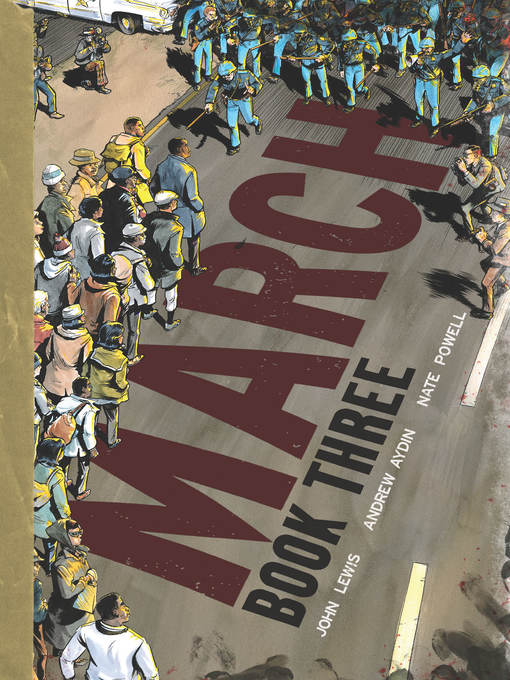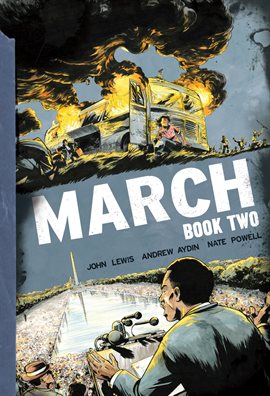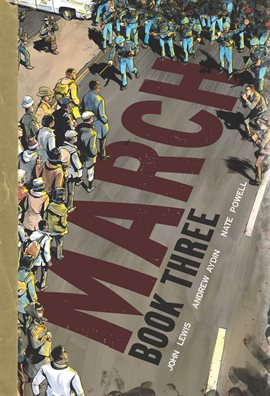1.
Language
English
Books
Summary
This graphic novel trilogy is a first-hand account of Congressman John Lewis' lifelong struggle for civil and human rights, meditating in the modern age on the distance traveled since the days of Jim Crow and segregation. Rooted in Lewis' personal story, it also reflects on the highs and lows of the broader civil rights movement. Book one spans Lewis' youth in rural Alabama, his life-changing meeting with Martin Luther King, Jr., the birth of the Nashville Student Movement, and their battle to tear down segregation through nonviolent lunch counter sit-ins, building to a stunning climax on the steps of City Hall. Book two takes place after the Nashville sit-in campaign. His commitment to justice and nonviolence has taken him from an Alabama sharecropper's farm to the halls of Congress, from a segregated schoolroom to the 1963 March on Washington D.C., and from receiving beatings from state troopers, to receiving the Medal of Freedom awarded to him by Barack Obama, the first African-Amer
Electronic Access
2.
Language
English
Regular print
Summary
This graphic novel is Congressman John Lewis' first-hand account of his lifelong struggle for civil and human rights, meditating in the modern age on the distance traveled since the days of Jim Crow and segregation. Rooted in Lewis' personal story, it also reflects on the highs and lows of the broader civil rights movement. Book One spans Lewis' youth in rural Alabama, his life-changing meeting with Martin Luther King, Jr., the birth of the Nashville Student Movement, and their battle to tear down segregation through nonviolent lunch counter sit-ins, building to a climax on the steps of City Hall. His commitment to justice and nonviolence has taken him from an Alabama sharecropper's farm to the halls of Congress, from a segregated schoolroom to the 1963 March on Washington D.C., and from receiving beatings from state troopers, to receiving the Medal of Freedom awarded to him by Barack Obama, the first African-American president.
View Other Search Results
3.
Language
English
Regular print
Summary
After the success of the Nashville sit-in campaign, John Lewis is more committed than ever to changing the world through nonviolence -- but as he and his fellow Freedom Riders board a bus into the vicious heart of the Deep South, they will be tested like never before. Faced with beatings, police brutality, imprisonment, arson, and even murder, the young activists of the movement struggle with internal conflicts as well. But their courage will attract the notice of powerful allies, from Martin Luther King, Jr. to Attorney General Robert F. Kennedy ... and once Lewis is elected chairman of the Student Nonviolent Coordinating Committee, this 23-year-old will be thrust into the national spotlight, becoming one of the "Big Six" leaders of the civil rights movement and a central figure in the landmark 1963 March on Washington for Jobs and Freedom.
Electronic Access
Image (OCoLC)900305945 (OCoLC)948567443 (OCoLC)958699173 (OCoLC)973619188 URL http://www.mackin.com/BookPics/Book.aspx?isbn=9781603094009
4.
Language
English
Books
Summary
By the fall of 1963, the Civil Rights Movement has penetrated deep into the American consciousness, and as a chairman of the Student Nonviolent Coordinating Committee, John Lewis is guiding the tip of the spear. Through relentless direct action, SNCC continues to force the nation to confront its own blatant injustice, but for every step forward, the danger grows more intense: Jim Crow strikes back through legal tricks, intimidation, violence, and death. The only hope for lasting change is to give voice to the millions of Americans silenced by voter suppression: "One Man, One Vote." To carry out their nonviolent revolution, Lewis and an army of young activists launch a series of innovative campaigns, including the Freedom Vote, Mississippi Freedom Summer, and an all-out battle for the soul of the Democratic Party waged live on national television. With these new struggles come new allies, new opponents, and an unpredictable new president who might be both at once. But fractures within t
Language
English
Books
Summary
A history professor describes the impact and history of the opening speech made during the March on Washington for Jobs and Freedom on August 28, 1963 by the trade unionist A. Philip Randolph whose vision and fight for equal economic and social citizenship began in 1941. He first called for a march on Washington in 1941 to press for equal opportunity in employment and the armed forces. He called for an end to segregation and a living wage for every American. Randolph's egalitarian vision of economic and social citizenship is the strong thread running through the full history of the March on Washington Movement. It was a movement of sustained grassroots organizing linked locally to women's groups, unions, and churches across the country. This work delivers a new understanding of this emblematic event and the broader civil rights movement it propelled.--Publisher information.
Limit Search Results









